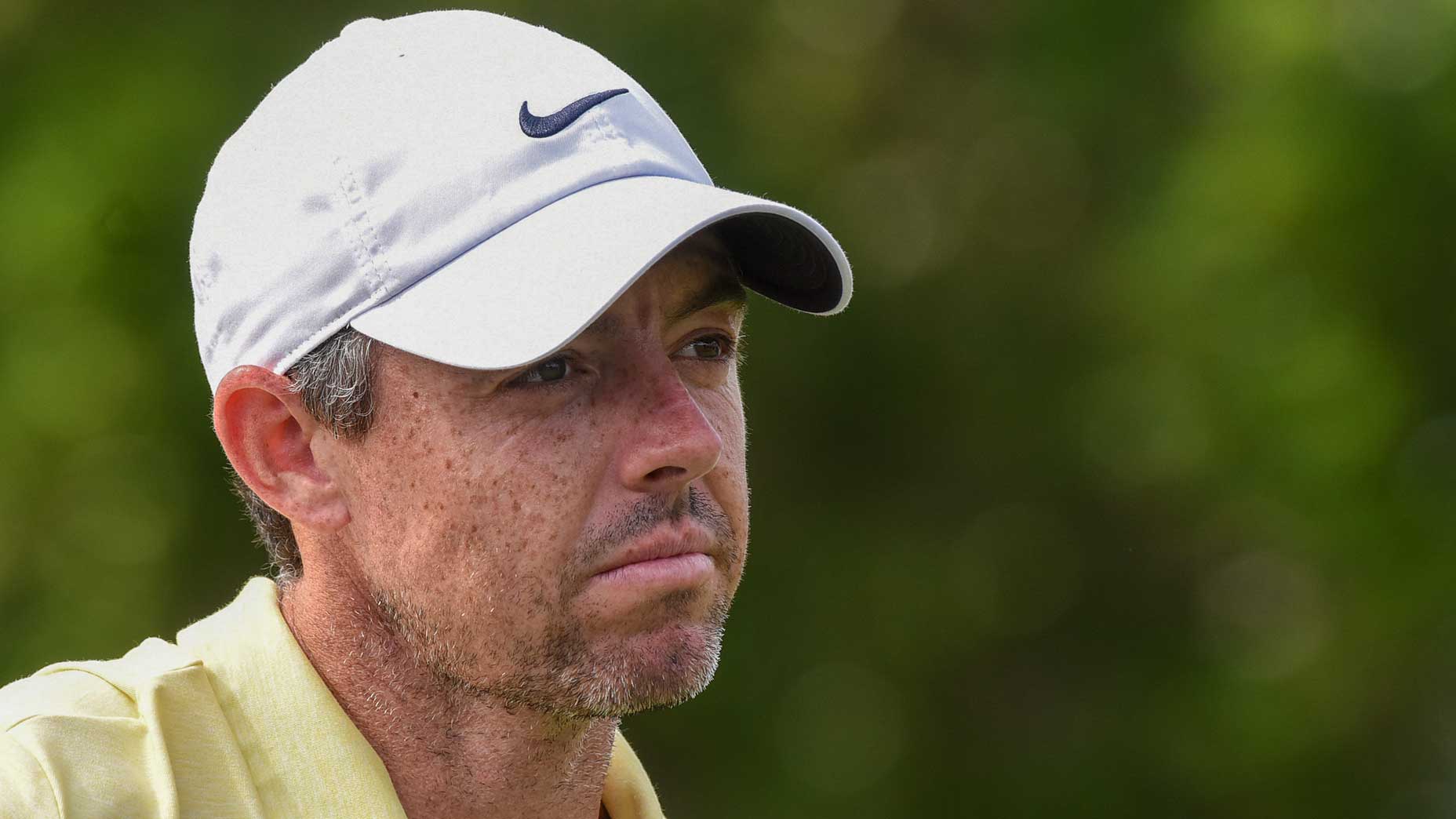Golf Logo
What Rory McIlroy REALLY means by a ‘cutthroat’ PGA Tour
SHARE
- Share on Facebook
- Share on Twitter
- Share by Email
InsideGOLF Holiday Bonus
FREE GOLF HAT
Rory McIlroy's vision of a more 'cutthroat' PGA Tour has plenty of meaning behind it.
Getty Images
Rory McIlroy has said a lot of things the last few years. He’s been a PGA Tour leader, defender, board member, etc. Every Tour pro’s opinion matters, but McIlroy’s has weight. Which is why he continues to get asked about the structure of a future Tour, and what that would look like if he was in charge. He’s been generous with his time and interested in talking. We can appreciate that.
This week, McIlroy caused a bit of a stir by saying he believes the PGA Tour should be more “cutthroat” and that he was in favor of there being fewer PGA Tour cards. In short, a smaller Tour. He admitted that mindset “won’t be very popular” and he’s right. But that doesn’t mean he’s wrong.
McIlroy offered that thought on Friday and then was asked to detail it more Saturday. In a world where the Tour was more cutthroat with its total number of players, what would that total membership look like — 100 players? 150 players? Fewer?
“I guess I haven’t thought about it that hard,” McIlroy said. “I guess my thing is, I’m all for more cutthroat and more competitive and trying to give pathways to the younger generation. So, through Korn Ferry Tour, through PGA Tour U … I just feel like there’s a lot of categories on Tour that people are sort of still benefiting off what they did like five or 10 years ago. I feel like the most competitive professional golf tour in the world, you should have to come out and prove yourself year after year after year.”
I don’t have a direct window into McIlroy’s head, but I would call the first part of this a slight fib. I imagine he has thought about it pretty hard. Why?
1. He spent almost two full years on the PGA Tour Policy Board during the Tour’s most transformational era, part of which was defined by the creation of limited-field events, almost exclusively filled by top players and the best recent performers. He has considered the differences of 50-, 70-, or 90-person fields, and thus a 50-, 70-, or 90-player elite tour. McIlroy sat in countless meetings and listened to the opinions of dozens of his peers as the Tour began to shape itself into a pyramid of access. He’s definitely thought about it.
2. McIlroy has also been pretty forthright about this opinion in the past. Even though he seems to get asked these structural questions every week he plays — and for that, we should sympathize with him, because it’s all been well archived — he’s been saying it (or something similar) for quite awhile.
Rewind to the 2023 Genesis Invitational, where McIlroy discussed the PGA Tour’s biggest events by saying this: “The best players should be playing in them because ultimately the PGA Tour needs to be built around the best players because that’s what will maximize the value of the product.”
Then, it was exactly one year ago this week where McIlroy repeated three words when asked about building out the upper echelon fields: “Shoot the scores.” In effect, the Tour is going to downsize slightly for the sake of competition, so shoot better scores and you’ll be involved. It’s as simple as that, and it’s similar to what he shared with reporters at Bay Hill this weekend, where McIlroy said he believes the Tour could be more cutthroat in deciding who gets Tour membership and thus access to its slate of events.
Most weeks, Tour players earn entry into events via a priority ranking. If they’ve won a tournament within the previous two seasons, they’ll qualify via “former winner” category. If they’ve won the FedEx Cup in the last five years — like Viktor Hovland a year ago — they’ll rank higher on that list because that’s a better category of qualification. Major-winners from the last five years rank highest, and rightfully so. The higher up the list, the better access to Tour events. (Put differently, the higher up the list, the fewer competitors able to bump you down and out of a field.)
Even though McIlroy is perennially one of the best players in the world — and thus ranked very high on the list — the ranking mostly matters for players with a worse pedigree. Those who are grinding to retain status, or who have fallen off form from where they used to be. McIlroy simply thinks there are too many categories on that list that allow for pros to continue entering tournaments in 2024 via achievements from, say, 2018, 2019 or 2020.
So, who is he really talking about? McIlroy is far too smart to name names, but there are certain players who continue to gain access via past accomplishments despite showing little form in recent years. Some of those players only have a bite of access. Take Jason Dufner, for example.
Duf has played just one Tour event this year, which is fitting for how he’s played the last few seasons (zero top 125 FEC finishes since 2018). That event was The AmEx, which Dufner qualified for since he was a former champion of that event, winning in 2016. Past champions of specific events is the 17th-highest category on the priority ranking, higher even than a handful of players who made it to the Tour Championship in 2023. All of this is a very technical way of saying that for that individual week, Jason Dufner is entered before the likes of Tommy Fleetwood or Cameron Young.
A separate case involves Webb Simpson, who has not finished in the top 125 of the FedEx Cup either of the last two seasons. He did, however, win the Players Championship in 2018, which brings with it a 5-year exemption on Tour. With the 2020 season essentially not mattering for these exemptions — similar to the Covid redshirt rule in college athletics — Simpson is still serving out the final year on that exemption from a victory that took place 11 months before Tiger Woods 2019 Masters win.
Simpson hasn’t exactly come out firing in 2024, either, but doesn’t have to worry about his 2025 status because there’s another category he’d slide into next season: top 50 career earnings. At the end of any PGA Tour season, players who are within the top 50 of the Tour’s career earnings list can use a season-long exemption that ranks even higher, 11th, on the list. Simpson is 15th all-time — thanks, in part, to a number of LIV Golf departures above him — so he will continue to be allowed into Tour events, even if his form doesn’t change, based on his achievements from years ago.
Simpson is definitely not alone in this endeavor. Francesco Molinari continues to earn plenty of starts from his 2018 Open Championship, which brings with it a 5-year exemption. Molinari has not finished in the top 125 of the FedEx Cup since 2019, but he can play any non-Signature Event he likes this year, despite missing more cuts than he has made on Tour the last three years. That Open victory has been good to him.
Ultimately, Charley Hoffman might present the most interesting case. Hoffman is playing this season on that top 50 all-time earners exemption, and even though he has finished outside the FedEx Cup top 125 the last two years, he can still enter every non-Signature event he’d like. All it takes is one great week, one four-day stretch of great golf, and that’s what Hoffman found at the Waste Management Phoenix Open. He lost in a playoff to Nick Taylor, but he did earn a bunch of FedEx Cup points, which he’ll use to potentially enter every single event again he wants next season.
In McIlroy’s perfect world, would Hoffman have received access to the WMPO? Maybe. McIlroy’s issue with the current system is likely not that the players named above (or any similar to them) are considered for Tour membership, but that they might have a higher priority ranking than the newest crop of young players from the Korn Ferry Tour, the DP World Tour or even PGA Tour University. 2024 has been a particularly difficult year for players further down the priority list to enter the biggest events, like the WMPO. Only a couple players from the DP World Tour ranked high enough to enter that event, and only the highest single performer from the Korn Ferry Tour earned his way in.
Should Hoffman and similar performers hold on to a breath of status for past achievements for multiple years down the road? To an extent, yes, but should the up-and-comers be forced to wait for a more limited amount of opportunities as a result? That’s what McIlroy really thinks should be discussed at the highest level.

Golf.com Editor
Sean Zak is a writer at GOLF Magazine and just published his first book, which follows his travels in Scotland during the most pivotal summer in the game’s history.



